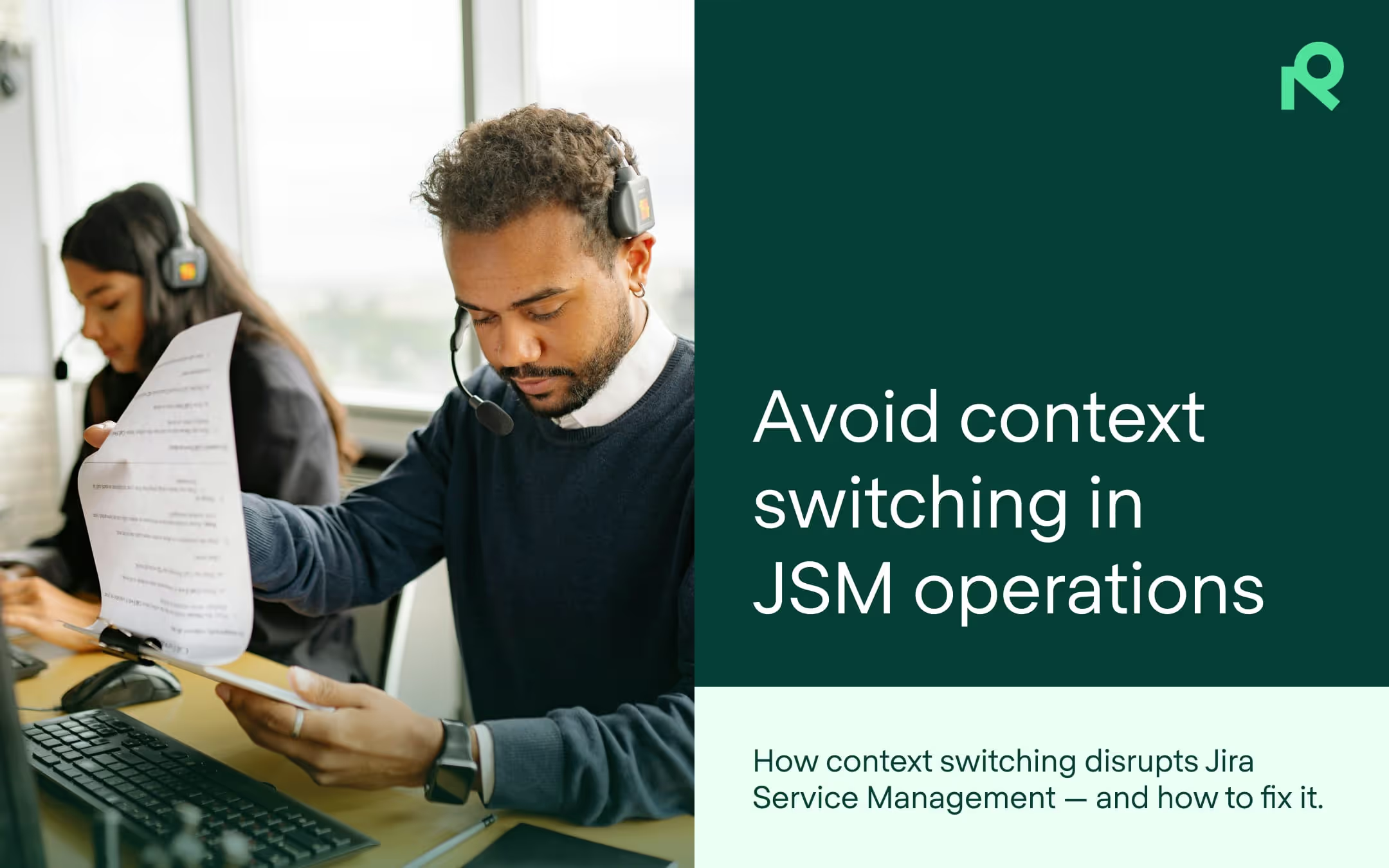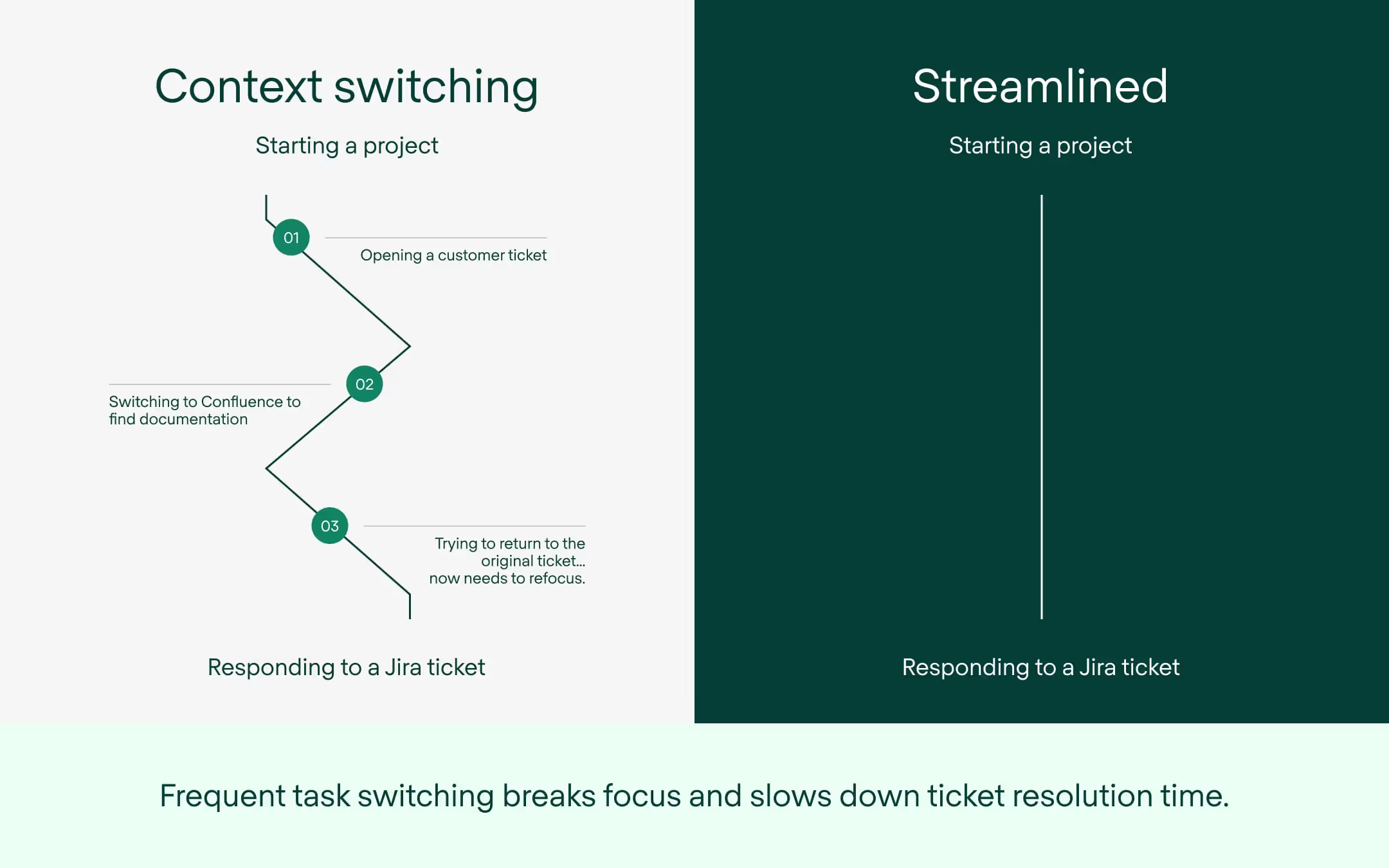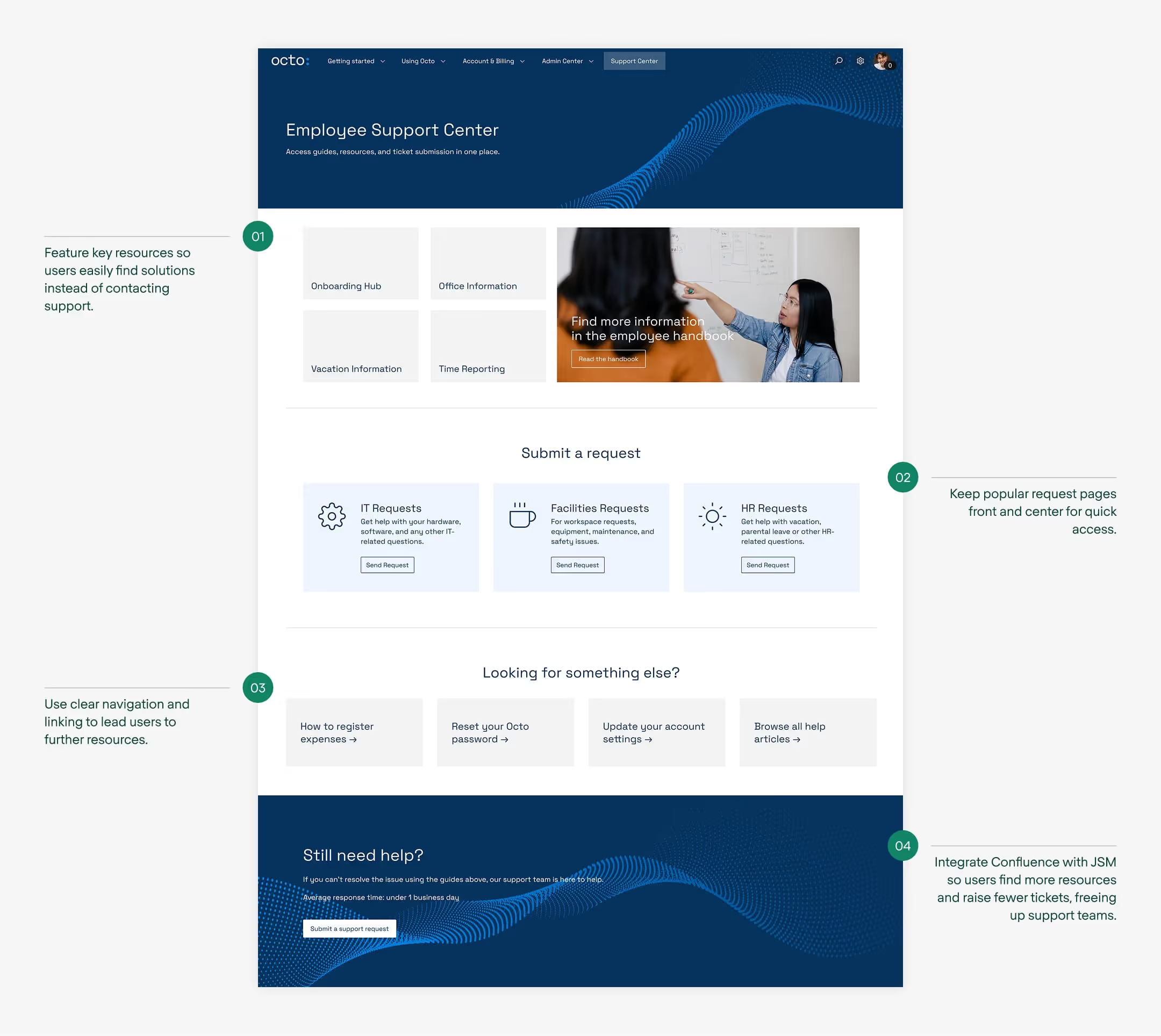Avoiding context switching in your service management operations

Context switching slows down users and support teams in JSM. Learn how it impacts focus, productivity, and satisfaction, and explore practical ways to reduce it.
We’ve all been there. Hyper-focused on resolving a task, when something breaks your flow — a site refuses to load or an urgent request lights up your browser. Concentration is broken, time is lost, and frustration creeps in.
It’s called context switching, and it can hurt not just the end user experience but also performance for admins and support teams.
In service management, context switching typically occurs when users or admins have to bounce between tasks, forms, or tabs to get something done, making it hard to stay focused.
In this blog post, we’ll examine how context switching could be severely hampering your users' JSM experience, and what steps you can do to prevent it on your support site or help desk.
Context switching causes havoc on users and support teams alike
For users, context switching introduces cognitive overload. A simple support-seeking experience can turn complex, with users often switching between FAQs, support forms, and help articles. Each time they pause to find a new resource or restart their search in a different tool, they lose focus on the original task. This interruption can lead to frustration, decreased productivity, and even abandonment of the support request process altogether.
According to research, it can take on average nine and a half minutes to get back into a flow state after a context switch. That kind of interruption can be a significant setback when it occurs again and again. For someone simply trying to solve an issue or get help, these delays can add unnecessary stress and reduce their confidence in the support system.
For support teams, the ripple effects of context switching are just as problematic. Teams often need to toggle between ticketing systems, internal documentation, and communication tools to respond to requests. These interruptions can lead to miscommunication, duplication of efforts, or even errors in resolving tickets. Hopping between tasks in this way can cause support personnel to feel overwhelmed, impacting both response times and the quality of support they provide.
Additionally, fragmented processes create inefficiencies that amplify over time. For example, if a support team member needs to repeatedly search for a solution that isn’t readily available, their workload increases unnecessarily. This delays ticket resolution and prevents teams from focusing on more strategic initiatives, like improving knowledge bases or proactively addressing recurring issues.

From both perspectives, context switching undermines the goal of a smooth, efficient support process. It transforms what should be a straightforward experience into one riddled with interruptions and inefficiencies. For organizations, this means lower satisfaction for both users and employees — affecting both customer retention and team morale.
What causes context switching in service operations?
While context switching in general is the result of many attention-disrupting factors, there’s several things in service operations specifically that can drive context switching.
For users
- Repetitive form-filling
Users may need to re-enter the same information across different forms or tickets, leading to frustration and wasted time. - Redundant searches
Poorly optimized Confluence knowledge bases or search functionality can force users to sift through multiple articles or FAQs, often without finding the right information. This drives them to switch tasks or escalate the issue unnecessarily. - Unclear categorization
A disorganized JSM support portal can make it difficult for users to identify the right forms, ticket categories, or knowledge articles. This confusion increases context switching as users jump between options, trying to find the right path.
For support teams
- Siloed tools and data
Support teams may need to navigate between separate tools for ticketing, customer data, and knowledge articles. This fragmentation slows down responses as necessary context must be pieced. - Scattered knowledge resources
Inconsistent or poorly integrated knowledge bases in Confluence and JSM can force agents to switch between multiple repositories, wasting time, and breaking focus. - Unclear ticket context
Incomplete or ambiguous tickets require agents to gather missing information by switching to other systems or escalating internally, delaying resolution.
How to conquer context switching in JSM
1. Organize your site structure with intuitive navigation
Design your JSM spaces to reduce unnecessary user navigation. Organize content by user role or task, grouping related content together as makes sense, and make sure to label pages clearly. Use logical hierarchies to make it easy for your users to find the right help resources.
Make a landing page that consolidates common support resources, FAQs, and links to popular help articles in one place. A central hub of information makes it easy for your users to get started with the right resources or request forms.
2. Implement Confluence and JSM support integration
It’s crucial to avoid sending users to separate places for self-help and support. The way to accomplish that in Atlassian is through integrating Confluence and JSM. Refined Sites allows users to create JSM tickets directly from Confluence pages when they can't find the answer they need, reducing the need to jump between tools.
Users often turn to knowledge bases in Confluence to troubleshoot issues. With an integration, they can create a JSM ticket directly from a Confluence page if they can’t find the answer they need. This creates a unified navigation experience for users, helps them stay in their flow while reducing confusion and frustration from needing multiple tools.
3. Smarten-up your request forms
Build your request forms to be easy to follow. Complex, overloaded forms can lead to confusion, with users switching back and forth to verify what’s needed.
Reduce user decision fatigue by simplifying form choices, for example with clear labels, fewer options, and using JSM forms to show or hide fields using conditional logic. This can help your users make faster, more accurate choices.
However, make sure that your users can find what they need without jumping from form to page and back again — a huge annoyance. If possible, consider linking FAQs, troubleshooting steps, or relevant documentation within the ticket form itself, as doing so can keep users focused and helps prevent unnecessary tab-hopping.
4. Make use of professionally designed templates to guide your landing page planning
Custom templates in Confluence and Jira Service Management are valuable tools for reducing context switching by providing users with consistent, intuitive, and streamlined experiences. Using templates helps to ensure that similar tasks, such as creating knowledge articles or submitting support tickets, follow a standardized format. This consistency minimizes confusion for users, because they don’t need to figure out what information is required each time.
Refined Sites for JSM comes packed with dozens of distinct templates to help you map out our JSM landing pages. The templates can be customized for different user groups, such as IT teams, HR, or external customers, ensuring an intuitive and easy-to-navigate user experience.

At the same time, using pre-made landing page templates for your JSM support site or help desk can help you save time while guiding your design process.
5. Cater your JSM site to your unique user needs
Don’t forget about accessibility! Ensuring accessibility — including features like screen reader compatibility, large text options, and simple navigation — in your JSM support site demonstrates your organization’s commitment to user-centered support.
Similarly, offering support in multiple languages can be critical, especially if you support customers globally or in specific regions more than others. The app ITSM Language Translation for JSM Translate Customer Request by re:solution GmbH helps automatically translate JSM tickets on your site, allowing your users to open tickets in any language. For agents, this eliminates the need to switch tools for translation and empowers your existing team to support international users without expanding language-specific teams.
6. Connect your support tools to streamline agent workflows
Another major source of context switching happens on the agent side — especially when ticket responders need to consult customer information, emails, or sales history in other systems like HubSpot.
Integrations like HubSpot for Jira help reduce this switching by embedding relevant customer data directly into Jira tickets. This means agents don’t have to jump to a separate tool to see who the customer is, what previous interactions they’ve had, or what deals are in progress.
By giving agents the context they need at a glance, this integration drastically reduces back-and-forth, supports faster decisions, and improves collaboration between support and customer-facing teams.
Learn more in the video below, where our Raj Sehmi, Senior Enablement Manager, and Björn Dohler, co-CEO of re:solution GmbH, discuss context switching as well as app integrations to help improve JSM operations.
Final thoughts and further reading
Context switching is a silent productivity killer in service management operations, impacting both users seeking help and the teams tasked with providing it.
Atlassian admins are uniquely positioned to address these challenges by optimizing their JSM and Confluence environments. Reducing context switching requires a proactive approach — integrating tools to streamline workflows, ensuring knowledge bases are well-organized and accessible, and creating intuitive, user-friendly portals.
The benefits of tackling these challenges are well worth it. Improving workflows and Atlassian instances to better enable focus can empower both users and support teams. The end result is improved user satisfaction and a more resilient, high-performing support team.
- New to Refined Sites for JSM? Try it now with a 30-day free trial on the Atlassian Marketplace.
- Learn more about re:solution’s productivity and collaboration tools on the Atlassian Marketplace.
Read more about
Try Refined free for 30 days
























